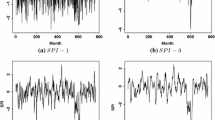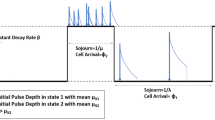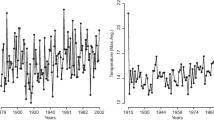Abstract
This paper uses rth-order categorical Markov chains to model the probability of precipitation. Several stationary and non-stationary high-order Markov models are proposed and compared using BIC. The number of parameters increases exponentially by adding the Markov order. Several classes of high-order Markov models are proposed which their increase of number of parameters are modest. For example models that use the number of precipitation days in a period prior to date, temperature of the previous day and sines/cosines periodic functions (to model the seasonality) are considered. The theory of partial likelihood is used to estimate the parameters. Parsimonious non-stationary first order Markov models with few seasonal terms are found optimal using BIC and temperature does not turn out to be a useful covariate. However BIC seems to underestimate the number of seasonal terms. We have also compared the results with AIC in some cases which tends to pick parsimonious models with more seasonal terms and higher order. We also show that ignoring seasonal terms result in picking higher order Markov chains. Finally we apply the methods to build confidence intervals for the probability of periods with no precipitation or low number of precipitation days in Calgary using historical data from 1980 to 2000.
Similar content being viewed by others
References
Akaike H (1974) A new look at the statistical model identification. IEEE Trans Autom Control 19: 716–723
Anderson TW, Goodman LA (1957) Statistical inference about Markov chains. Ann Math Stat 28: 89–110
Bartlett MS (1951) The frequency goodness of fit test for probability chains. In: Proceedings of the Cambridge Philosophical Society, pp 86–95
Chin EH (1977) Modeling daily precipitation process with Markov chain. Water Resources Research 13(6): 949–956
Ching WK, Fung ES, Ng KM (2004) . Higher-order Markov chain models for categorical data sequences Naval Res Log(51): 557–574
Gabriel KR, Neumann J (1962) A Markov chain model for daily rainfall occurance at Tel Aviv. Quart J Roy Meteorol Soc 88: 90–95
Hannan EJ (1980) The estimation of the order of an ARMA process. Ann Stat 8: 1071–1081
Harrison M, Waylen P (2000) A note concerning the proper choice for Markov model order for daily precipitation in the humid tropics: a case study in Costa Rica. Int J Climatol 20: 1861–1872
Haughton DMA (1988) On the choice of a model to fit data from an exponential family. Ann Stat 16(1): 342–355
Hosseini R (2009) Statistical models for agroclimate risk analysis. PhD thesis, Department of Statistics, UBC
Hosseini R, Zidek J, Le N (2009a) An analysis of Alberta’s climate. Part I: Non-homogenized data. Technical Report TR #245, Department of Statistics, UBC
Hosseini R, Zidek J, Le N (2009b) An analysis of Alberta’s climate. Part II: Homogenized data. Technical Report TR #246, Department of Statistics, UBC
Hosseini R, Zidek J, Le N (2009c) r-th order categorical Markov chains. Technical Report TR #248, Department of Statistics, UBC
Hosseini R, Zidek J, Le N (2010a) A characterization of categorical Markov chains. J Stat Theor Prac (to appear)
Hosseini R, Zidek J, Le N (2010b) Model selection for the binary dichotomized temperature processes. Technical Report TR #257, Department of Statistics, UBC
Kedem B, Fokianos K (2002) Regression models for time series analysis. Wiley Series in Probability and Statistics.
Mékis E, Hogg WD (1999) Rehabilitation and analysis of Canadian daily precipitation time series. At Ocean 37: 53–85
Moon SE, Ryo S, Kwon J et al (1993) A Markov chain model for daily precipitation occurrence in South Korea. Int J Climatol 14: 109–116
Nkemdirim LC (1988) On the frequency of precipitation-days in Calgary, Canada. Prof Geogr 40: 65–76
Raftery AE (1985) A model for higher order Markov chains. J Roy Stat Soc Ser B 47(3): 528–539
Schoof J, Pryor S (2008) On the proper order of Markov chain model for daily precipitation occurrence in the contiguous United States. J Appl Meteorol Climatol 47: 2477–2486
Schwartz G (1978) Estimating the dimension of a model. Ann Stat 6: 461–464
Shibita R (1976) Selection of the order of an authoregressive model by Akaike’s information criterion. Biometrika 63: 117–126
Tong H (1975) Determination of the order of a Markov chain by Akaike’s information criterion. J Appl Probab 12: 488–497
Tong H, Gates P (1976) On Markov chain modelling to some weather data. J Appl Meteorol 5: 1145–1151
Author information
Authors and Affiliations
Corresponding author
Additional information
This work was partially supported by grants from the Natural Science and Engineering Research Council of Canada and the National Institute for Complex Data Structures.
Rights and permissions
About this article
Cite this article
Hosseini, R., Le, N. & Zidek, J. Selecting a binary Markov model for a precipitation process. Environ Ecol Stat 18, 795–820 (2011). https://doi.org/10.1007/s10651-010-0169-1
Received:
Revised:
Published:
Issue Date:
DOI: https://doi.org/10.1007/s10651-010-0169-1




